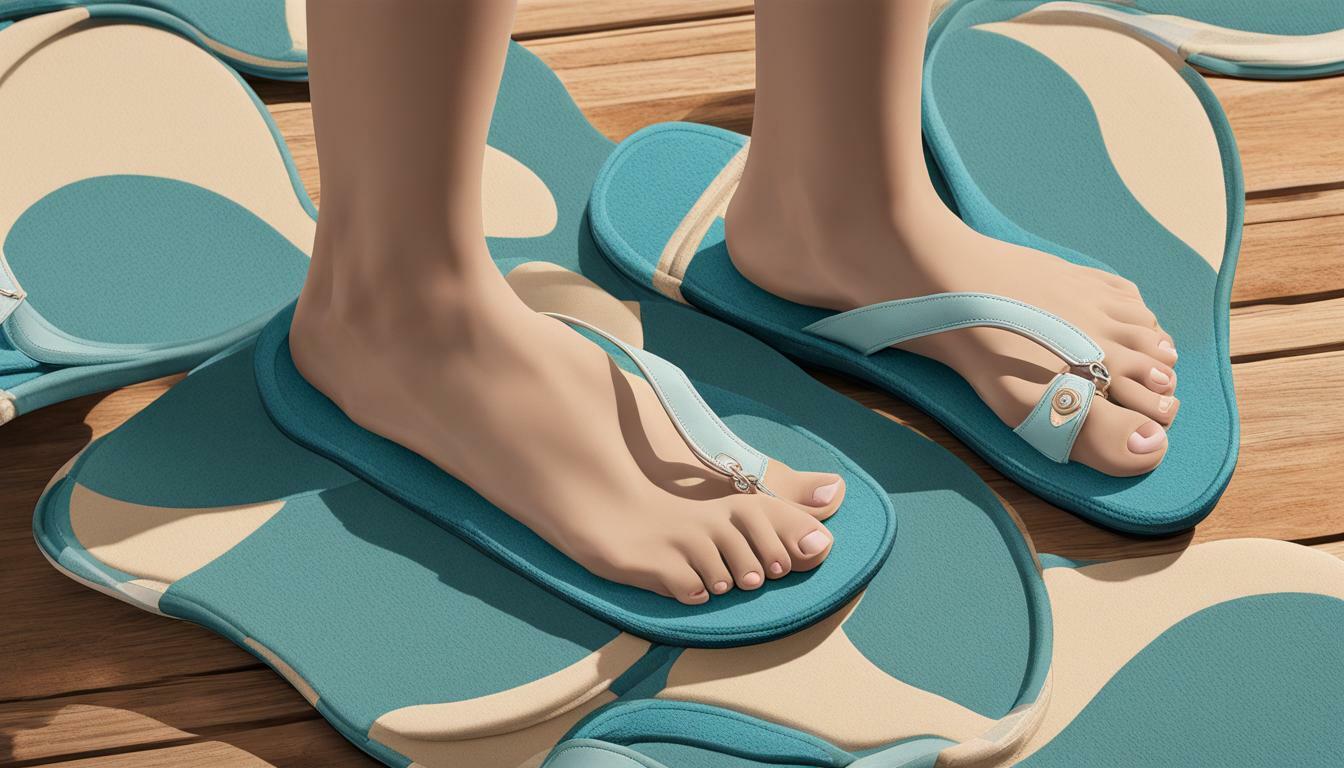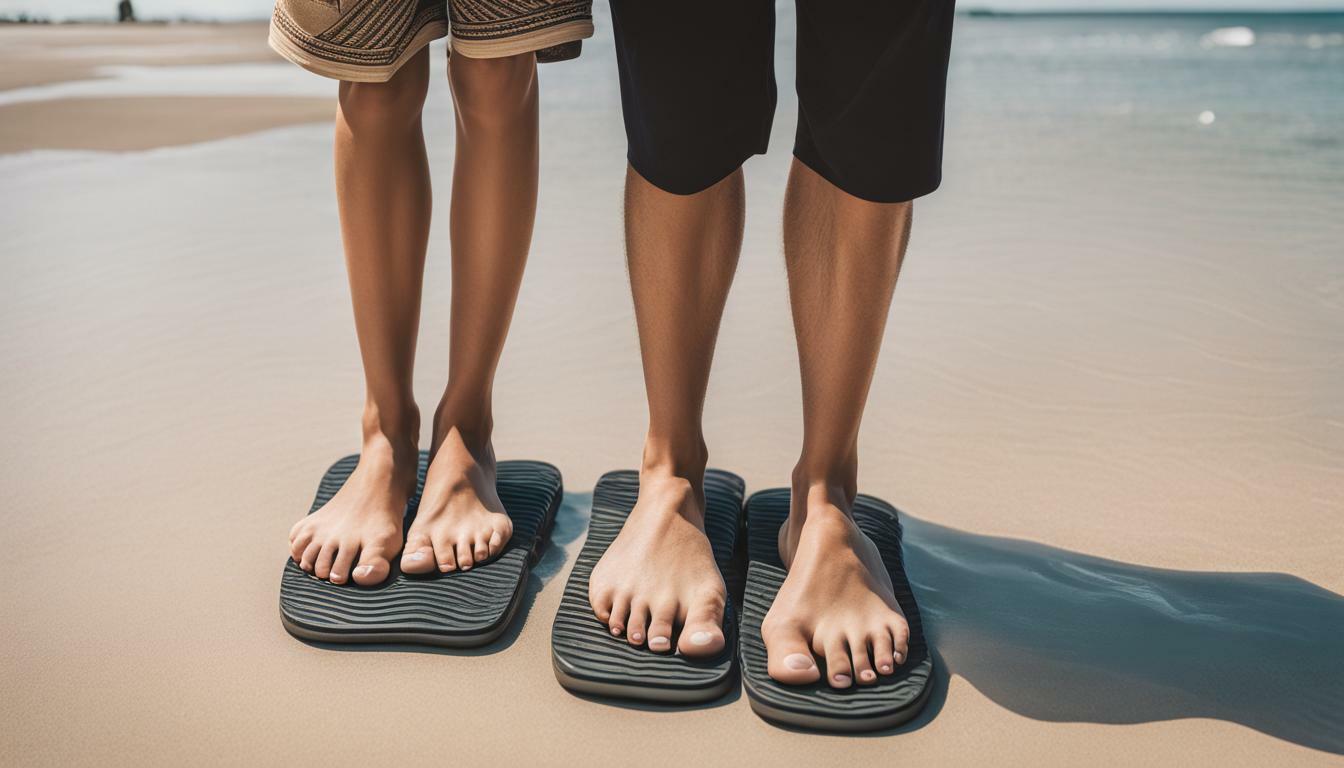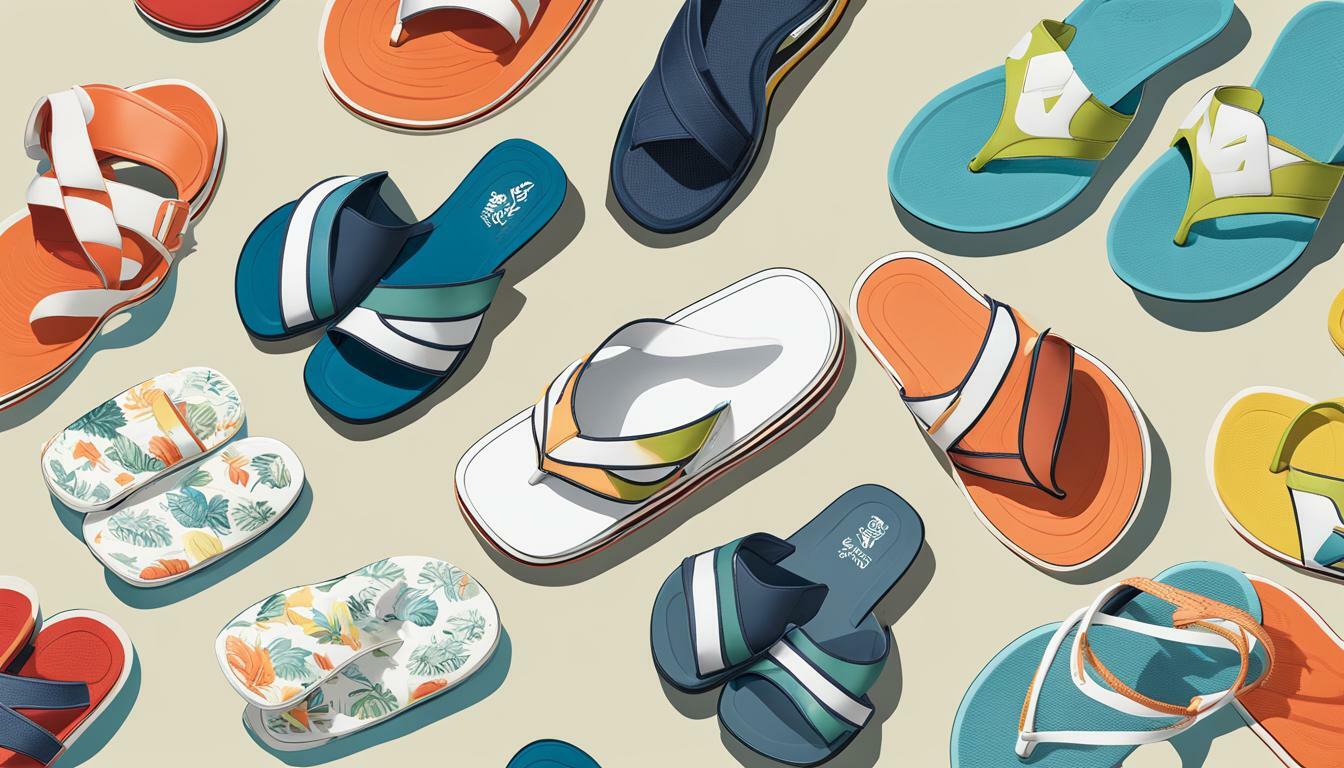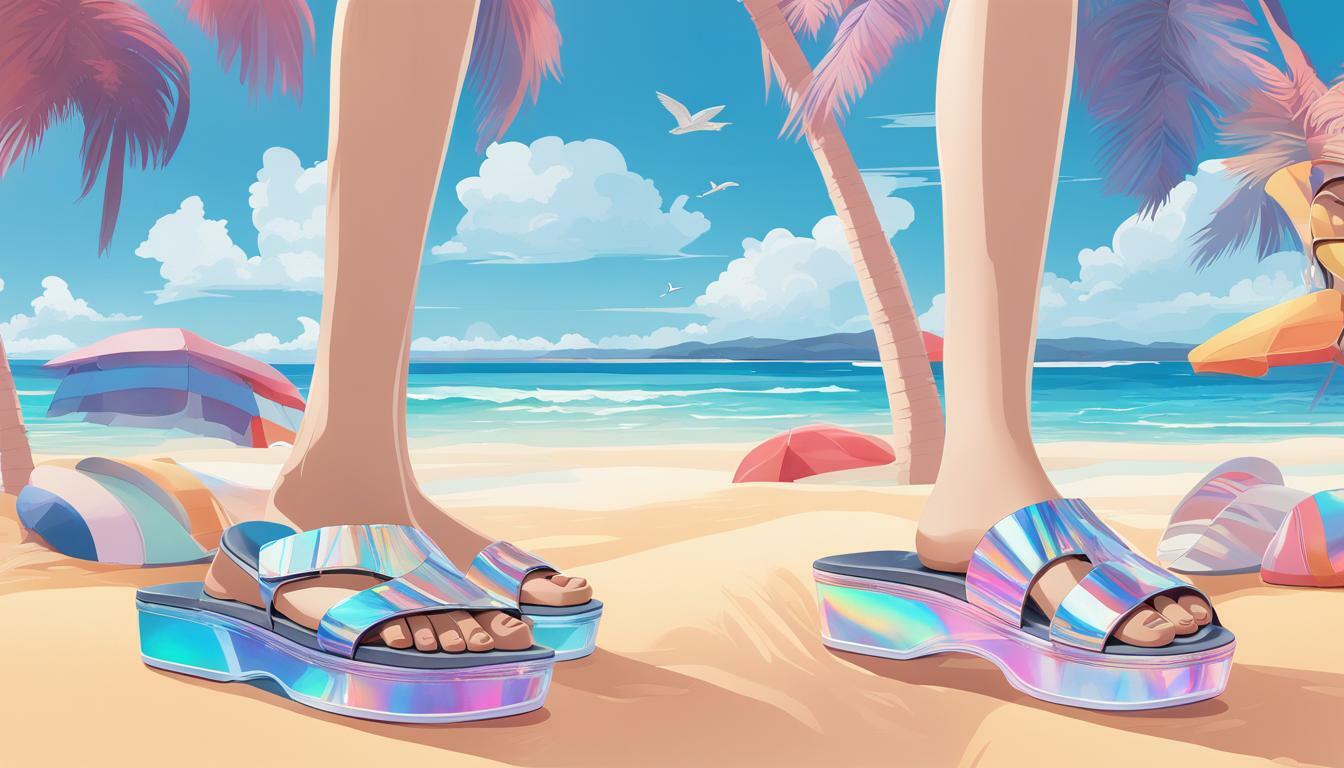When it comes to choosing the right footwear for your daily routine, there are many options to consider. Two popular choices are water-resistant flip-flops and terry cloth slippers. Both have their advantages and drawbacks, and understanding the differences between the two can help you make an informed decision.
Key Takeaways:
- Water-resistant flip-flops and terry cloth slippers serve different purposes and are suitable for different environments.
- The comfort, style, durability, versatility, price range, and maintenance requirements of each footwear option should be taken into account before making a purchase.
- Customer reviews and feedback can provide valuable insight into the performance and satisfaction of both water-resistant flip-flops and terry cloth slippers.
Comfort and Fit
When choosing between water-resistant flip-flops and terry cloth slippers, the comfort and fit should be at the forefront of your considerations. Both options are designed with different features to provide optimal comfort and fit for the wearer.
Water-resistant flip-flops are typically made with materials that conform to the shape of your foot over time, providing a custom fit. Look for options with cushioned footbeds, arch support, and adjustable straps for added comfort. These features can help prevent foot pain and discomfort, especially if you plan to wear them for extended periods.
Terry cloth slippers, on the other hand, offer warmth and softness but may not provide as much support as water-resistant flip-flops. Look for options with cushioned insoles and non-slip soles for added safety and comfort. Adjustable straps can also help accommodate different foot shapes and sizes.
Emphasizing Comfort and Fit
No matter which option you choose, it’s essential to prioritize comfort and fit to ensure an enjoyable wearing experience. Consider trying on different sizes and styles to find the best match for your feet. Don’t be afraid to invest in quality footwear that will provide long-lasting comfort and support.
Style and Design
One of the most significant differences between water-resistant flip-flops and terry cloth slippers is their style and design options. Water-resistant flip-flops are available in various vibrant colors, patterns, and prints, making them a fashionable choice for beachwear or poolside lounging. They also come with embellishments such as glitter, studs, and rhinestones for a glamorous touch. On the other hand, terry cloth slippers often come in more subdued colors such as white, beige, or grey, and their design is focused on comfort rather than fashion. They have a simple, classic design that can match any loungewear.
Water-resistant flip-flops are also designed to look more sporty and casual, with a thinner and more flexible sole that allows for greater mobility. They are often seen as more suitable for outdoor activities such as hiking, boating, or camping. Terry cloth slippers, on the other hand, have a bulkier design that prioritizes cushioning and warmth. They are ideal for indoor use, particularly in the colder months, as they can keep your feet cozy and comfortable while you relax at home.
In terms of design, both water-resistant flip-flops and terry cloth slippers have their strengths and weaknesses. If you prioritize fashion over comfort, water-resistant flip-flops are a great choice. However, if you value comfort and versatility, terry cloth slippers might be a better option.
Durability and Longevity
When it comes to durability and longevity, water-resistant flip-flops and terry cloth slippers have different characteristics. Water-resistant flip-flops are typically made with materials that are resistant to water and moisture, such as rubber or neoprene. This makes them more resistant to wear and tear over time, even with frequent exposure to water. On the other hand, terry cloth slippers are made with softer materials that are more susceptible to damage from water and wear. This means they may need to be replaced more frequently compared to water-resistant flip-flops.
Another factor that affects the durability of water-resistant flip-flops and terry cloth slippers is their construction. Water-resistant flip-flops usually have a simpler construction, with fewer parts that can break or become damaged. Terry cloth slippers, on the other hand, may have more elaborate designs that can be more prone to damage or wear and tear over time. However, this also means that terry cloth slippers can be repaired more easily compared to water-resistant flip-flops, which may need to be replaced entirely if a part becomes damaged.
| Water-resistant flip-flops | Terry cloth slippers | |
|---|---|---|
| Materials | Durable and resistant to water and moisture | Softer and more susceptible to damage from water and wear |
| Construction | Simple with fewer parts that can break or become damaged | Elaborate designs that can be more prone to damage or wear and tear over time |
To maximize the longevity of your water-resistant flip-flops or terry cloth slippers, proper maintenance and care are essential. It’s important to follow the manufacturer’s instructions for cleaning and storing your footwear. For water-resistant flip-flops, make sure to rinse them thoroughly after exposure to salt water or chlorine, which can cause damage over time. For terry cloth slippers, avoid exposing them to water as much as possible and make sure to air dry them completely before wearing them again.
In terms of long-term value, water-resistant flip-flops may offer a better return on investment due to their durable materials and simple construction. However, terry cloth slippers may offer a higher level of comfort and may be a better option for indoor use.
Versatility and Usage
When it comes to versatility and usage, both water-resistant flip-flops and terry cloth slippers have their strengths.
| Water-resistant flip-flops | Terry cloth slippers |
|---|---|
| Water-resistant flip-flops are perfect for outdoor activities such as swimming, beach trips, and camping. They are also suitable for quick errands or walks around the neighborhood on rainy days. | Terry cloth slippers are ideal for indoor use, especially during colder seasons. They keep your feet warm and cozy while relaxing at home. They are also perfect for use after a shower or bath. |
Both options are lightweight and easy to pack for travel, making them convenient choices for any trip.
Water-resistant flip-flops
- Great for outdoor activities such as swimming, beach trips, and camping.
- Suitable for quick errands or walks around the neighborhood on rainy days.
- Lightweight and easy to pack for travel.
- May not provide enough warmth during colder seasons or indoor use.
Terry cloth slippers
- Ideal for indoor use, especially during colder seasons.
- Keep your feet warm and cozy while relaxing at home.
- Perfect for use after a shower or bath.
- Lightweight and easy to pack for travel.
- May not be suitable for outdoor use or wet environments.
Ultimately, the choice between water-resistant flip-flops and terry cloth slippers depends on your personal needs and lifestyle. It’s best to consider where and how you’ll be using them before making a decision.
Price Range and Value
When it comes to price, water-resistant flip-flops and terry cloth slippers can vary depending on the brand, materials used, and additional features.
Water-resistant flip-flops tend to have a higher price point due to the materials used for their water-resistant properties, such as neoprene or rubber. You can expect to pay anywhere from $20 to $60 for a pair, depending on the brand and design.
Terry cloth slippers, on the other hand, are typically more affordable, with prices ranging from $10 to $30. The lower cost can be attributed to the materials used, such as cotton or polyester.
When considering the value of each option, it’s important to think about your specific needs. If you live in a wet or humid climate or plan to use your footwear near bodies of water, water-resistant flip-flops may be a worthwhile investment. However, if you prioritize comfort and a cozy feel for indoor use, terry cloth slippers may be a better value for you.
Maintenance and Care
Proper maintenance is essential for keeping your water-resistant flip-flops or terry cloth slippers in great condition. Here are some tips to keep them looking and feeling their best:
- Always check the care label or manufacturer’s instructions before washing your footwear.
- Water-resistant flip-flops can usually be cleaned with a damp cloth, but avoid using harsh chemicals or abrasives that could damage the material.
- Terry cloth slippers can usually be machine washed on a gentle cycle with mild detergent, but make sure to check the care label first.
- Air drying is the gentlest way to dry your footwear, but avoid exposing them to direct sunlight or heat sources that could cause them to warp or lose their shape.
- For water-resistant flip-flops with a footbed made of cork or other natural materials, consider using a specialized cleaner or conditioner to keep them looking and feeling their best.
- Regularly inspect your footwear for signs of wear and tear, such as loose threads or worn-out soles. If repairs are needed, consider taking them to a professional or doing them yourself if you have the necessary skills.
By following these tips, you can prolong the life of your water-resistant flip-flops or terry cloth slippers and keep them looking and feeling great for seasons to come.
Environmental Impact
As consumers, we have a responsibility to consider the environmental impact of our purchases, including our choice of footwear. When it comes to water-resistant flip-flops and terry cloth slippers, there are several factors to consider.
Water-resistant flip-flops are typically made from synthetic materials such as rubber or PVC, which can take hundreds of years to decompose in landfills. In addition, the manufacturing process for these materials can release harmful chemicals into the environment. Terry cloth slippers, on the other hand, are often made from natural materials such as cotton or bamboo, which are biodegradable and renewable. However, the production of cotton can be water-intensive and require the use of pesticides, while bamboo production can contribute to deforestation.
When it comes to disposal, water-resistant flip-flops are often not recyclable due to their material composition, while terry cloth slippers can be recycled or composted if made from natural materials. It’s worth noting that some brands offer eco-friendly options for both types of footwear, using sustainable materials and ethical production practices.
In conclusion, both water-resistant flip-flops and terry cloth slippers have environmental implications, and the best choice will depend on your personal values and priorities.
Customer Reviews and Feedback
If you’re considering purchasing water-resistant flip-flops or terry cloth slippers, it’s important to hear from real users about their experiences. Here are some reviews and feedback we found:
“I love my water-resistant flip-flops! They’re perfect for the beach and pool, and I don’t have to worry about ruining them if they get wet.” – Sarah
“I prefer terry cloth slippers because they provide more cushioning and support for my feet. Plus, they’re cozy to wear around the house.” – Michael
It’s clear that the choice between water-resistant flip-flops and terry cloth slippers ultimately comes down to personal preference and lifestyle needs. Consider the specific activities and environments you’ll be using them in, as well as the level of comfort and support you require. With the right choice, you’ll be able to enjoy comfortable and reliable footwear for years to come.
Conclusion
After considering the different factors discussed in this article, you should now have a better understanding of the benefits and drawbacks of water-resistant flip-flops and terry cloth slippers.
For those seeking a comfortable and secure fit, water-resistant flip-flops may be the better option. With features such as adjustable straps and arch support, they can provide a customized fit that is ideal for active lifestyles and outdoor activities.
Alternatively, terry cloth slippers may be the preferred choice for those seeking a cozy and soft feel. Their plush materials offer superior cushioning and moisture-wicking properties, making them a great pick for lounging around the house.
Ultimately, the decision between water-resistant flip-flops and terry cloth slippers will depend on your individual preferences and usage scenarios. Take into account factors such as style, durability, price range, and maintenance requirements to determine the best option for your needs.
Remember to also consider the environmental impact of your choice and try to opt for eco-friendly materials and sustainable manufacturing processes wherever possible.
By using the information and guidance provided in this article, you can make an informed decision and select the footwear option that suits you best.
FAQ
Q: Are water-resistant flip-flops suitable for all environments?
A: Water-resistant flip-flops are designed to withstand exposure to water and are ideal for beach outings, poolside activities, and other wet environments. However, they may not provide the same level of protection and support as closed-toe shoes in rugged or hazardous terrains.
Q: Can I wear terry cloth slippers outside?
A: While terry cloth slippers are primarily intended for indoor use, some styles may have an outdoor-friendly sole that allows for short trips outside. However, it’s important to note that prolonged outdoor use may cause premature wear and tear on terry cloth slippers.
Q: How do I clean water-resistant flip-flops?
A: To clean water-resistant flip-flops, simply rinse them with water and mild soap. Avoid using harsh chemicals or abrasive materials that can damage the material. Allow them to air dry before wearing or storing.
Q: Can I machine wash terry cloth slippers?
A: It is generally not recommended to machine wash terry cloth slippers, as this can cause shrinking or damage to the material. Instead, spot clean them with a damp cloth or sponge and mild detergent. Air dry them afterward.
Q: Are water-resistant flip-flops breathable?
A: While water-resistant flip-flops provide protection against water, they may not offer the same level of breathability as open-toe sandals or shoes. However, many water-resistant flip-flops feature perforations or ventilation channels to enhance airflow and prevent excessive sweating.
Q: Do terry cloth slippers provide arch support?
A: Terry cloth slippers are generally designed for comfort rather than specialized arch support. If you require significant arch support, consider using orthotic inserts or opting for slippers with built-in arch support.
Q: Can I wear water-resistant flip-flops in the shower?
A: Yes, water-resistant flip-flops are suitable for wearing in the shower to protect your feet from direct contact with the floor. They can also provide traction to prevent slipping on wet surfaces.
Q: How do I prevent odors in terry cloth slippers?
A: To prevent odors in terry cloth slippers, allow them to air dry between uses to reduce moisture buildup. You can also sprinkle baking soda inside the slippers overnight to absorb any unwanted odors. Regularly washing or replacing the insole can also help maintain freshness.
Q: Can water-resistant flip-flops be worn with socks?
A: Water-resistant flip-flops are typically designed to be worn without socks, as the materials used are quick-drying and comfortable against bare feet. However, if you prefer wearing socks, look for styles with a roomier fit to accommodate them.
Q: Are terry cloth slippers suitable for outdoor activities?
A: Terry cloth slippers are primarily designed for indoor activities and may not provide the necessary traction, support, and durability for outdoor use. It’s generally best to wear them inside or in low-impact outdoor settings, such as a patio or garden.



